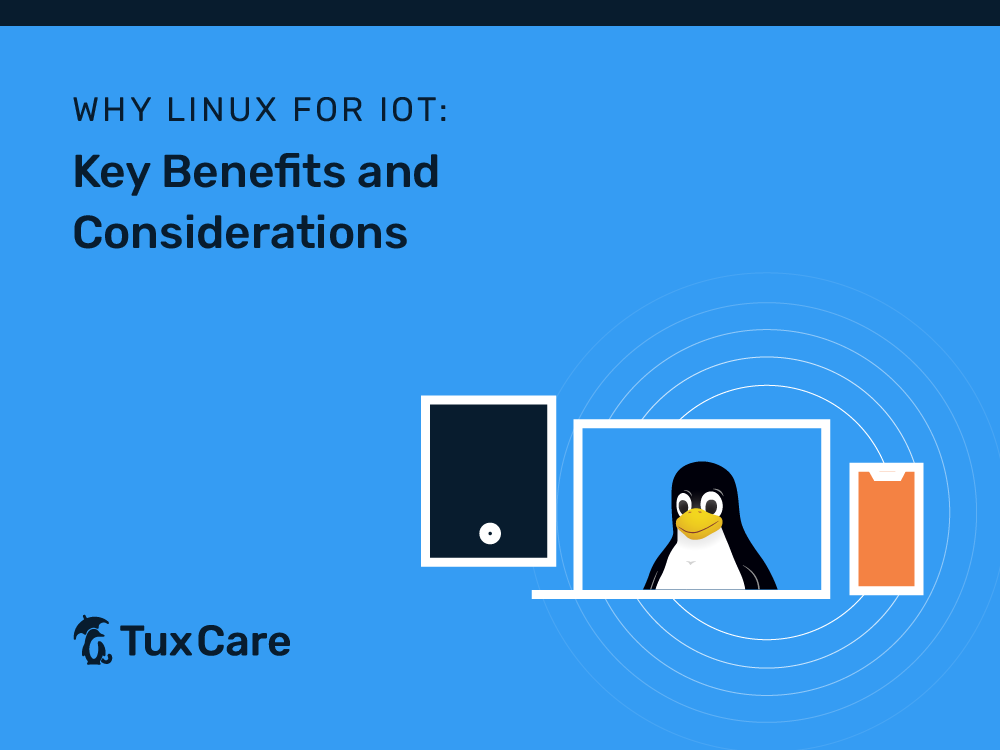Linux for IoT: Key Benefits and Considerations
IoT stands for Internet of Things. It refers to manufacturing equipment, vehicles, household appliances, and other devices that are embedded with sensors, software, and communication capabilities. These devices can exchange data and interact with each other, often without human intervention. The goal of the Internet of Things (IoT) is to make our lives and businesses more efficient, convenient and interconnected. Examples of IoT devices include smart thermostats, fitness trackers, and home security systems.
For IoT devices to operate effectively, they require a stable and flexible operating system. Linux for IoT has emerged as a top choice among developers due to its open-source nature and numerous advantages. In this blog post, we’ll discuss what makes Linux the best operating system for IoT devices, discuss some of the most popular Linux distributions for IoT systems along with some key criteria to consider when choosing the specific distribution.
Why Linux for IoT?
One of the main Linux advantages is its versatility. Unlike proprietary operating systems, Linux can be customized to meet the specific needs of a particular device or application. This is particularly important for IoT technology, which often requires unique configurations. Linux’s modular design allows developers to select only the necessary components, reducing the size and complexity of the operating system.
Furthermore, Linux’s lightweight design allows it to run on low-power devices, which are frequently used in IoT applications.
Another advantage of Linux for IoT is its security. IoT devices are often vulnerable to cyberattacks because they are connected to the Internet and may serve as an entry point to the corporate network. Linux’s security features have proven themselves, and the open-source nature of the operating system means that any vulnerabilities are quickly identified and addressed. The operating system alone does not, of course, guarantee the security of IoT devices by default. It requires a holistic approach combining the advantages of Linux alongside rigorous security measures.
Top Linux Distributions for IoT
Several Linux-based operating systems are popular choices for IoT devices. Here are some of them and why they are preferred:
- Raspberry Pi OS (formerly Raspbian): Raspberry Pi OS is a lightweight, Debian-based operating system optimized for Raspberry Pi single-board computers. It’s popular for IoT projects because it provides excellent compatibility with Raspberry Pi hardware, a large and active community, and easy access to GPIO (General Purpose Input/Output) pins for hardware interfacing.
- Yocto Project: The Yocto Project is not a standalone operating system but a set of tools and templates for creating custom Linux distributions for embedded systems and IoT devices. It’s popular among manufacturers and developers who need full control over the components and configurations of their IoT operating systems.
- Ubuntu Core: Ubuntu Core is a minimal, container-based version of Ubuntu designed for IoT and embedded systems. It offers security through a transactional update mechanism, which ensures that updates can be applied without breaking the system. It’s also compatible with a wide range of hardware platforms.
- OpenWrt: OpenWrt is Linux-based firmware for embedded devices, especially popular for routers and networking equipment. It’s highly customizable, open source, and optimized for performance. OpenWrt allows developers to create IoT devices with networking capabilities easily.
- BalenaOS: BalenaOS, formerly known as Resin OS, is designed specifically for containerized IoT applications. It leverages Docker and container technology to make it easier to deploy and manage applications on IoT devices at scale. It’s often used for edge computing and remote device management.
- Zephyr: Zephyr is an open-source, real-time operating system (RTOS) designed for resource-constrained IoT devices. It’s highly portable and supports a wide range of microcontrollers. Zephyr is suitable for low-power and battery-operated IoT devices.
- Contiki: Contiki is another lightweight operating system designed for low-power, memory-constrained IoT devices. It’s known for its small footprint and energy efficiency, making it suitable for IoT applications requiring long battery life.
- Tizen: Tizen is an open-source, Linux-based operating system primarily developed by Samsung and the Linux Foundation. While it’s not as widely used in IoT as other options, it has found applications in smart TVs, wearables, and some IoT devices due to its versatility.
Selecting the Perfect Linux for IoT Project
Developers and manufacturers select the operating system that best fits their specific project needs and objectives. Here are some factors that need to be considered when choosing a Linux-based operating system for an IoT project:
- Hardware Compatibility: Ensure that the chosen OS is compatible with the hardware platform you intend to use. IoT devices come in various forms and may have different architectures, so the OS must support the target hardware.
- Resource Constraints: Assess the resource limitations of your IoT devices, such as CPU power, RAM, and storage. Select an OS that can operate efficiently within these constraints to avoid performance issues and excessive resource usage.
- Real-Time Requirements: Determine whether your IoT application requires real-time capabilities. If so, consider an OS or real-time operating system (RTOS) that can meet your timing and responsiveness requirements.
- Security: Security is a top priority for IoT devices, as they can be vulnerable to cyberattacks. Choose an OS that offers robust security features, regular updates, and a strong security community. In critical IoT systems, consider live patching solutions like KernelCare for IoT to minimize the vulnerability window and ensure 100% device uptime.
- Power Efficiency: If your IoT devices are battery-powered or need to conserve energy, choose an OS that can optimize power usage and support low-power modes.
- Scalability: Consider whether the OS can scale to accommodate a large number of devices if your IoT project requires scalability and the ability to manage a growing fleet of devices.
- Community and Support: A strong and active user and developer community can be invaluable. It provides access to resources, forums, and troubleshooting assistance. Choose an OS with an established and supportive community.
- Networking and Connectivity: Consider the networking and communication protocols required for your IoT application. Ensure that the OS supports the necessary wireless technologies (e.g., Wi-Fi, Bluetooth, LoRa, Zigbee) and network stacks.
- Compliance and Regulations: Ensure that the selected OS complies with industry-specific regulations and standards that may apply to your IoT application, such as data privacy laws or industry-specific certifications.
- Ecosystem: Consider the availability of libraries, frameworks, and third-party integrations that can simplify development and enhance functionality for your IoT project.
In conclusion, as IoT technology continues to shape our interconnected world, the choice of the right Linux-based OS becomes paramount for developers and manufacturers alike. The versatility of Linux, with its ability to adapt to specific hardware and configurations, stands out as a key advantage. Its lightweight design, security features, and support for low-power modes make it an ideal choice for IoT devices.



 Documentation
Documentation Login
Login




